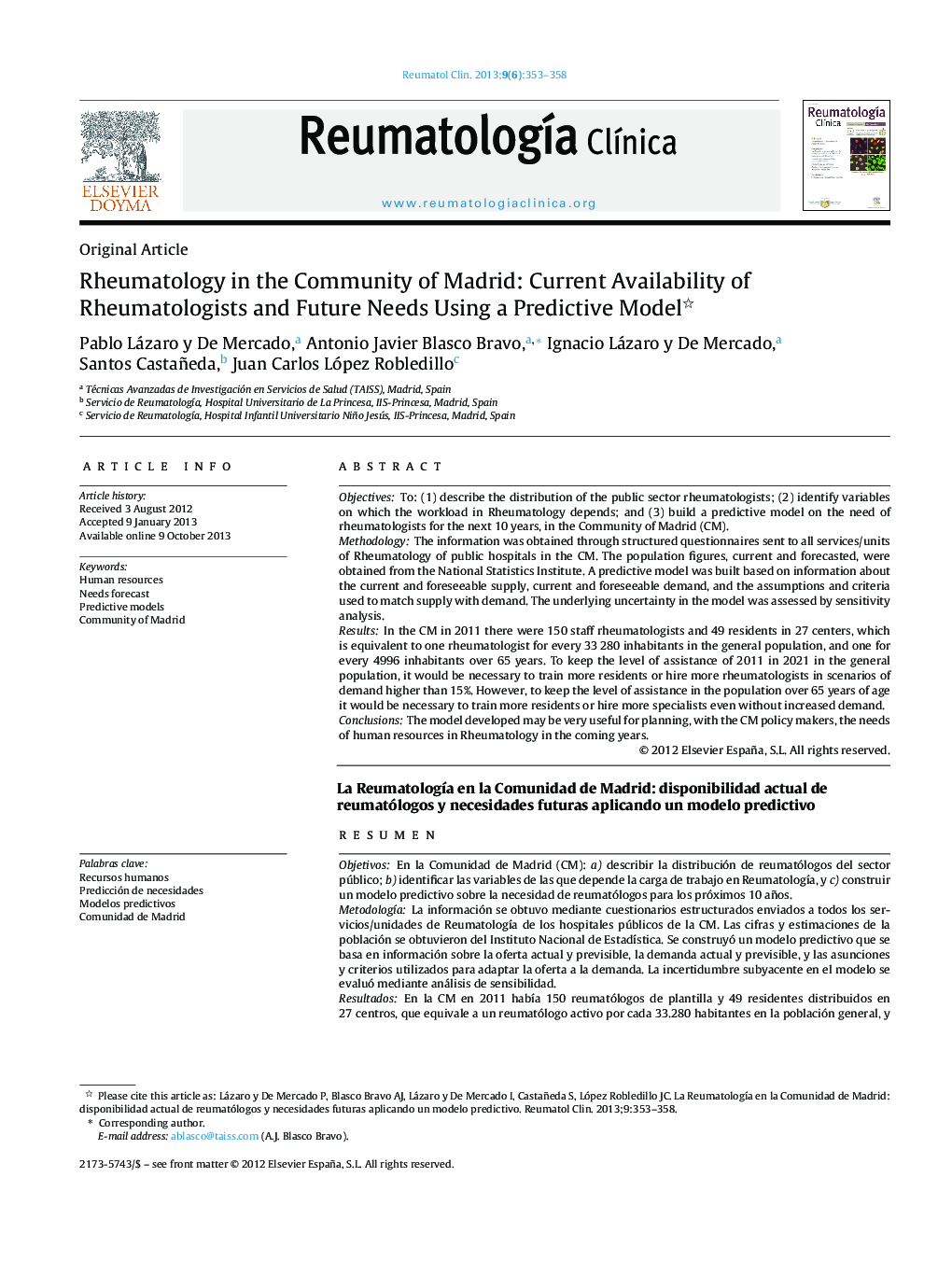| کد مقاله | کد نشریه | سال انتشار | مقاله انگلیسی | نسخه تمام متن |
|---|---|---|---|---|
| 3384403 | 1220527 | 2013 | 6 صفحه PDF | دانلود رایگان |

ObjectivesTo: (1) describe the distribution of the public sector rheumatologists; (2) identify variables on which the workload in Rheumatology depends; and (3) build a predictive model on the need of rheumatologists for the next 10 years, in the Community of Madrid (CM).MethodologyThe information was obtained through structured questionnaires sent to all services/units of Rheumatology of public hospitals in the CM. The population figures, current and forecasted, were obtained from the National Statistics Institute. A predictive model was built based on information about the current and foreseeable supply, current and foreseeable demand, and the assumptions and criteria used to match supply with demand. The underlying uncertainty in the model was assessed by sensitivity analysis.ResultsIn the CM in 2011 there were 150 staff rheumatologists and 49 residents in 27 centers, which is equivalent to one rheumatologist for every 33 280 inhabitants in the general population, and one for every 4996 inhabitants over 65 years. To keep the level of assistance of 2011 in 2021 in the general population, it would be necessary to train more residents or hire more rheumatologists in scenarios of demand higher than 15%. However, to keep the level of assistance in the population over 65 years of age it would be necessary to train more residents or hire more specialists even without increased demand.ConclusionsThe model developed may be very useful for planning, with the CM policy makers, the needs of human resources in Rheumatology in the coming years.
ResumenObjetivosEn la Comunidad de Madrid (CM): a) describir la distribución de reumatólogos del sector público; b) identificar las variables de las que depende la carga de trabajo en Reumatología, y c) construir un modelo predictivo sobre la necesidad de reumatólogos para los próximos 10 años.MetodologíaLa información se obtuvo mediante cuestionarios estructurados enviados a todos los servicios/unidades de Reumatología de los hospitales públicos de la CM. Las cifras y estimaciones de la población se obtuvieron del Instituto Nacional de Estadística. Se construyó un modelo predictivo que se basa en información sobre la oferta actual y previsible, la demanda actual y previsible, y las asunciones y criterios utilizados para adaptar la oferta a la demanda. La incertidumbre subyacente en el modelo se evaluó mediante análisis de sensibilidad.ResultadosEn la CM en 2011 había 150 reumatólogos de plantilla y 49 residentes distribuidos en 27 centros, que equivale a un reumatólogo activo por cada 33.280 habitantes en la población general, y por cada 4.996 habitantes mayores de 65 años. Para mantener el nivel de asistencia de 2011 en 2021 en la población general, solo sería necesario formar más residentes o contratar más reumatólogos en escenarios de aumento de la demanda superior al 15%. Sin embargo, para mantenerlo en la población mayor de 65 años, sería necesario formar más residentes o contratar más especialistas, aún sin aumento de la demanda.ConclusionesEl modelo desarrollado es muy útil para planificar con los responsables de la CM las necesidades de recursos humanos en Reumatología en los próximos años.
Journal: Reumatología Clínica (English Edition) - Volume 9, Issue 6, November–December 2013, Pages 353–358